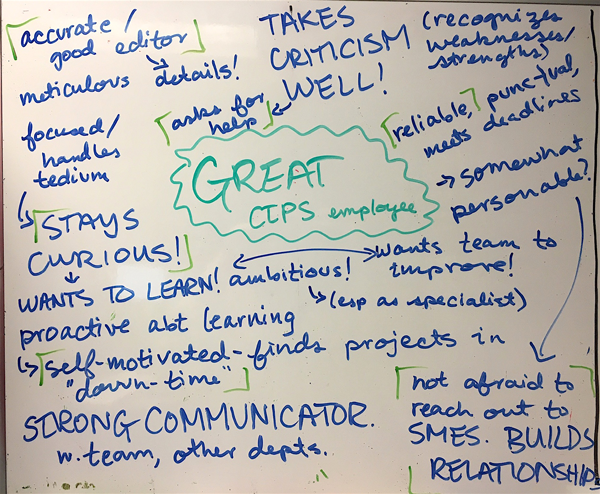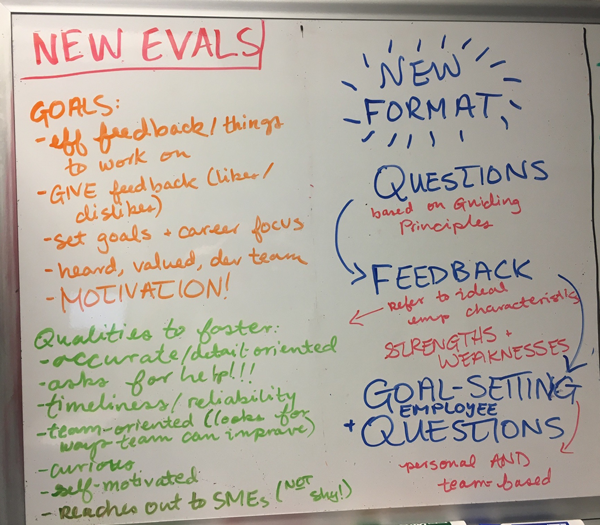Developing a holistic, personalized evaluation process

Quick Info
- Project: CTPS Team Evaluations
- Timeline: April 2020 to July 2020
Performance evaluations at SkyWest Airlines are very de-centralized. Every team has their own method of performing annual evaluations. The Corporate Technical Publications and Standards (CTPS) team evaluations were based on a “points” system that felt arbitrary and inorganic, especially considering performance evaluations at SkyWest Airlines are not tied to compensation.
Objective
I wanted to transition to a more holistic evaluation method that was more in line with my leadership style. I was especially hoping that each evaluation would help solidify team member’s career goals, strengths and challenges as an employee, and general job satisfaction.
My Role

I created and implemented a new evaluation process and appropriately documented it in our department manuals.
Challenges
Because there was no company-wide blueprint for how evaluations should be performed, I was very hesitant to scrap and rewrite the entire system my predecessor had left behind, despite the fact that it was no longer very helpful for our team. Additionally, my team tends to be entry-level editors; in most cases, this is their first job in an office, and I wanted to make sure I was presenting a professional and equitable evaluation so they knew what to expect going forward. To top it all off, I was performing this rewrite while the entire team was working remotely (due to COVID-19), so I had to find ways to create a personal connection with the employee.
Approach

First, I did some research as to what other teams throughout the company were using for evaluations. I reviewed past evaluations I had performed and identified what information had felt most helpful to the team. I sought advice from department leadership, and I read a few books on leadership (The Speed of Trust by Stephen Covey Jr. and Start With Why by Simon Sinek were two that I read) and thoughtfully considered the objectives I wanted the evaluations to accomplish:
- Provide the employee with effective feedback on their strengths and weaknesses.
- Give the employee the chance to provide their own feedback on their job generally (projects they like and dislike, etc.)
- Create a framework for the employee to set goals and help focus any career and professional development aspirations.
- Emphasize to the employee that they are valued and their feedback affects how the team develops.
Final Product
I created a new employee review process that included two main components: a self-evaluation that the employee completes in advance of their evaluation and a worksheet for a manager evaluation. In the self-evaluation, the employee answers questions such as:
- What goals did you accomplish and not accomplish since your last evaluation?
- Name someone at the company with whom you’d like to collaborate (and why). It can be any person, from any department.
The manager review is structured to begin with a quick review of the employee’s job duties and responsibilities, and then jumps into a miniature “interview” of 6-7 questions. The three questions I always ask are:
- How is your work/life balance?
- From what you’ve seen since working here, how do you think our team can improve our service to the company?
- Where do you want your career to go from your current role (whether inside or outside SkyWest)? How can I help you make it happen?
From there, I add three or four more questions depending on the circumstances. While we’ve been working remotely, I usually include another question about productivity: how have they felt their work has been since working remotely, anything I can do to help, etc.
In the formation of the new evaluations, I referred to SkyWest’s guiding principles to help me write the questions and refocus any priorities. I also wanted each evaluation to end with tangible and quantifiable “action items” for both the employee and myself.




Outcome
Through the new evaluation system, I learned so much more about the team’s work styles and goals. Rather than checking off boxes, it helped me understand what everyone was aiming towards.
- I was able to learn that one of my employees felt they struggled with managing their stress, which was something I never would have learned otherwise (this employee always struck me as very serene and level-headed).
- I learned that one employee, who was an enthusiastic team member but had never taken ownership of any specific project, was having a hard time finding what they were passionate about; as a result, we crafted a few different projects for them to try and isolate the type of work they most enjoyed.
- I learned that one of my team members who was an extremely strong editor did not enjoy writing, and I responded to that preference accordingly with the assignments they were assigned.